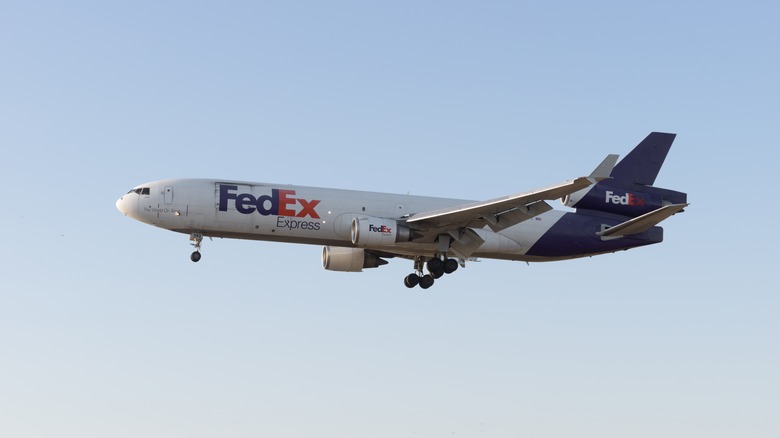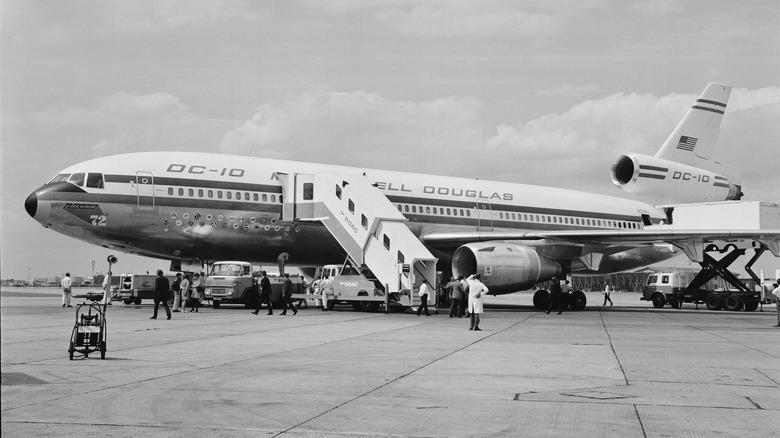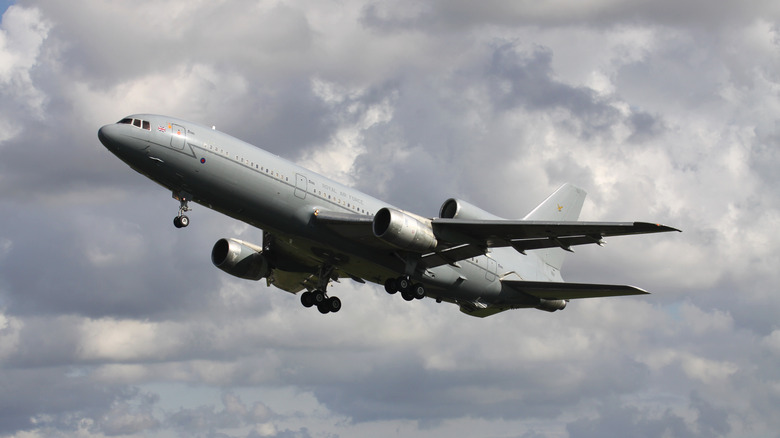What's The Biggest Difference Between The DC-10 And L-1011 Trijets?
The McDonnell Douglas DC-10 and the Lockheed L-1011 TriStar are arguably the best aircraft of the trijet era. While both planes had several differences, what truly set them apart was the configuration of their third engines. The DC-10 and L-1011 came with three powerful high-bypass ratio turbofan engines, thus their classification under the trijet name. However, the most significant difference between the two aircraft is that while the DC-10 had its tail engine above its fuselage, the L-1011 had its engine inside the tail cone.
The trijet era saw a big boom in the mid-to-late 20th century thanks to its planes' fuel efficiency and low cost of production. While the first three-engine aircraft, the Tupolev Tu-73, took to the skies in 1947, it wasn't until the 1960s that these planes started seeing extensive commercial use. From the Hawker Siddeley Trident to the Dassault Falcon 900, these planes set a standard for air travel that is still emulated to date. Although many impactful planes came from this period, none surpassed the prominence of the DC-10 and the L-1011.
The McDonnell Douglas DC-10
The DC-10 jet was McDonnell Douglas Corporation's most controversial plane, given the bad luck that seemed to follow it. The aircraft was built to replace the DC-8 quad jet, thanks to its long-distance capabilities and improved passenger capacity. Although it succeeded in this, gaining status for its fuel efficiency, auto landing system, and transcontinental travel, its reputation ultimately turned sour after several catastrophic crashes.
Regardless, the DC-10 was a work of art. The original plane, the DC-10-10, sported a General Electric CF-6 turbofan engine under each wing, with the third at the base of the tailfin. The aircraft had a 4,000-mile range, which allowed it to fly between continents. Its large, wide body could also seat between 250 and 380 passengers.
The DC-10 came in three models: the DC-10-10, as mentioned above, the DC-10-30, and the DC-10-40. Each variant had specific dimensions. The 10-10's length was 182 feet, 3.1 inches, its wingspan 155 feet by 4 inches, and its height 57 feet, 6 inches. For the 10-30 and 10-40, the wingspan was 165 feet by 4 inches, and the height was 57 feet by 7 inches. But the 10-30's length was 181 feet 7 inches, while the 10-40's was 182 feet by 2 inches. The DC-10 saw commercial success mainly because of its low cost of operation as compared to the Boeing 747 and L-1011. It was also cheaper to board, making it a favored option compared to the luxurious L-1011.
The Lockheed L-1011 TriStar
Lockheed Corporation's L-1011 TriStar was air luxury made manifest. Like the DC-10, the L-1011 came with three engines. However, the L-1011's tail engine was mounted inside the fuselage, improving stability while reducing drag. Lockheed only installed Rolls-Royce's RB211 turbofan engines on the L-1011, unlike McDonnell Douglas, who used engines from different manufacturers on the DC-10.
The L-1011 was 177 feet by 8.5 inches long and had a wingspan of 155 feet by 4 inches. Its height was 55 feet by 4 inches, and its seating capacity was between 256 and 400. It had a 3,579-mile max range and an unmatched safety record, making it a popular option among many travelers. The plane also had wide aisle cabins, glare-resistant windows, two elevators, and a below-deck gallery, defining air luxury. The Rolls-Royce engines were also known for their steady hum, which added to the overall appeal of the plane as a luxury aircraft.
Despite its impressive features, the Lockheed L-1011 TriStar ran into several problems that eventually tanked what could have been a mighty aerial run. Perhaps the greatest of these issues was Rolls-Royce's 1971 bankruptcy, which affected the plane's production and overall sales. Lockheed's additional financial issues and controversy centered around finding a willing market for the aircraft further damaged an already tainted name.


